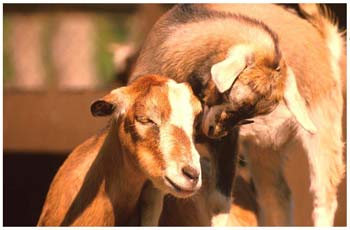Caprine Health Management
General Information
Goat production is on the rise in the United States. Accurate figures for US goat numbers are not yet available. The US Department of Agriculture has just recently begun to monitor Caprine numbers in their census.
The Anglo Nubian is the most popular dairy breed in many States. However, French Alpine (also known as Oberhasli), Saanen, Toggenbergs and Lamancha herds may also be present.
The Boer goat is the newest and most popular of the meat breeds. They are well known for their thick meaty carcasses that grow fast and full with minimal investments in concentrates.
 Goats have also gained popularity as pets here. Any breed may be raised and used as a companion animal. The importance of understanding and explaining the difference in nutritional requirements for pet goats verses production animals to owners cannot be over emphasized. Pygmy goats are the most common pet breeds in most states. Goats are becoming increasingly popular for both production and companionship. Goats have also gained popularity as pets here. Any breed may be raised and used as a companion animal. The importance of understanding and explaining the difference in nutritional requirements for pet goats verses production animals to owners cannot be over emphasized. Pygmy goats are the most common pet breeds in most states. Goats are becoming increasingly popular for both production and companionship.
Goats can be raised for meat, milk, cashmere and mohair fibers, skins, hiking and packing or just for pets & fun! Goats are generally very adaptable animals and can be kept in a variety of climates and circumstances. They are very good climbers and jumpers and are known for their curiosity. They will generally chew on anything. They are browsers and unlike sheep will eat off higher weed and shrubs. Proper management of a goat herd or even an individual pet requires basic knowledge of health care and management. This can ensure a better profit margin or just a more enjoyable pet and it can certainly lead to a healthier, happier goat!
Herds can be routinely tested and certified for brucellosis and tuberculosis. Herds may also be routinely tested for CAE, Johnes, Contagious Ecthyma and common trace mineral deficiencies. Minimum vaccination recommendations are Clostridium prefringens Type C,D, Tetanus and Rabies.
goat-doc@mymobilevet.com

|

